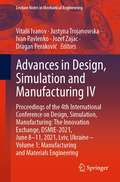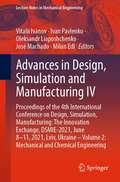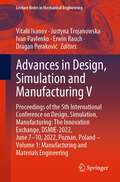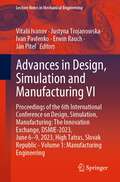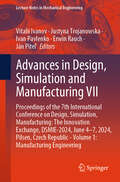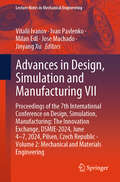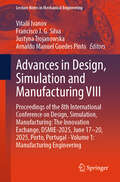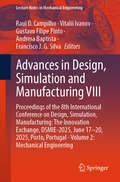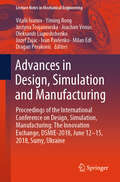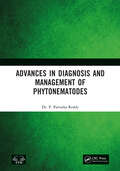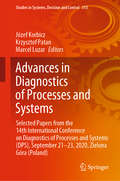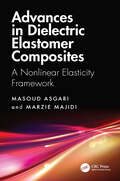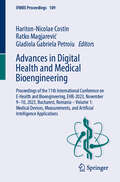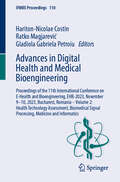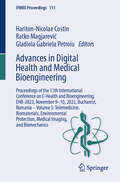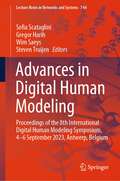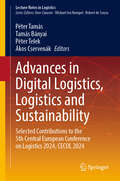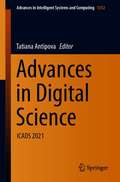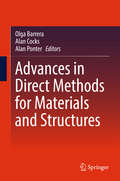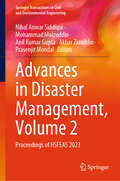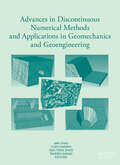- Table View
- List View
Advances in Design, Simulation and Manufacturing IV: Proceedings of the 4th International Conference on Design, Simulation, Manufacturing: The Innovation Exchange, DSMIE-2021, June 8–11, 2021, Lviv, Ukraine – Volume 1: Manufacturing and Materials Engineering (Lecture Notes in Mechanical Engineering)
by Vitalii Ivanov Justyna Trojanowska Jozef Zajac Ivan Pavlenko Dragan PerakovićThis book reports on topics at the interface between manufacturing and materials engineering, with a special emphasis on product design and advanced manufacturing processes, intelligent solutions for Industry 4.0, covers topics in ICT for engineering education, describes the numerical simulation and experimental studies of milling, honing, burnishing, grinding, boring, and turning, as well as the development and implementation of advanced materials. Based on the 4th International Conference on Design, Simulation, Manufacturing: The Innovation Exchange (DSMIE-2021), held on June 8-11, 2021, in Lviv, Ukraine, this first volume of a 2-volume set provides academics and professionals with extensive information on trends, technologies, challenges and practice-oriented experience in the above-mentioned areas.
Advances in Design, Simulation and Manufacturing IV: Proceedings of the 4th International Conference on Design, Simulation, Manufacturing: The Innovation Exchange, DSMIE-2021, June 8–11, 2021, Lviv, Ukraine – Volume 2: Mechanical and Chemical Engineering (Lecture Notes in Mechanical Engineering)
by José Machado Vitalii Ivanov Oleksandr Liaposhchenko Ivan Pavlenko Milan EdlThis book reports on topics at the interface between mechanical and chemical engineering, emphasizing design, simulation, and manufacturing. Specifically, it covers recent developments in the mechanics of solids and structures, numerical simulation of coupled problems, including fatigue, fluid behavior, particle movement, pressure distribution. Further, it reports on developments in chemical process technology, heat and mass transfer, energy-efficient technologies, and industrial ecology. Based on the 4th International Conference on Design, Simulation, Manufacturing: The Innovation Exchange (DSMIE-2021), held on June 8-11, 2021, in Lviv, Ukraine, this second volume of a 2-volume set provides academics and professionals with extensive information on trends, technologies, challenges and practice-oriented experience in the above-mentioned areas.
Advances in Design, Simulation and Manufacturing V: Proceedings of the 5th International Conference on Design, Simulation, Manufacturing: The Innovation Exchange, DSMIE-2022, June 7–10, 2022, Poznan, Poland – Volume 1: Manufacturing and Materials Engineering (Lecture Notes in Mechanical Engineering)
by Vitalii Ivanov Justyna Trojanowska Ivan Pavlenko Dragan Peraković Erwin RauchThis book reports on topics at the interface between manufacturing and materials engineering, with a special emphasis on smart and sustainable manufacturing. It describes innovative research in design engineering and manufacturing technology, covering the development and characterization of advanced materials alike. It also discusses key aspects related to ICT in engineering education. Based on the 5th International Conference on Design, Simulation, Manufacturing: The Innovation Exchange (DSMIE-2022), held on June 7-10, 2022, in Poznan, Poland, this first volume of a 2-volume set provides academics and professionals with extensive information on trends and technologies, and challenges and practice-oriented experience in all the above-mentioned areas.
Advances in Design, Simulation and Manufacturing V: Proceedings of the 5th International Conference on Design, Simulation, Manufacturing: The Innovation Exchange, DSMIE-2022, June 7–10, 2022, Poznan, Poland – Volume 2: Mechanical and Chemical Engineering (Lecture Notes in Mechanical Engineering)
by José Machado Vitalii Ivanov Oleksandr Liaposhchenko Ivan Pavlenko Milan EdlThis book reports on topics at the interface between mechanical and chemical engineering, emphasizing aspects related to design, simulation, and manufacturing. It covers recent findings concerning the mechanics of fluids, solids, and structures, and numerical and computational methods for solving coupled problems in manufacturing. Further, it reports on recent developments in chemical process technology, heat and mass transfer research, and energy-efficient technologies, describing applications in the food and energy production sector. Based on the 5th International Conference on Design, Simulation, Manufacturing: The Innovation Exchange (DSMIE-2022), held on June 7-10, 2022, in Poznan, Poland, this second volume of a 2-volume set provides academics and professionals with extensive information on trends and technologies, and challenges and practice-oriented experience in all the above-mentioned areas.
Advances in Design, Simulation and Manufacturing VI: Proceedings of the 6th International Conference on Design, Simulation, Manufacturing: The Innovation Exchange, DSMIE-2023, June 6–9, 2023, High Tatras, Slovak Republic - Volume 1: Manufacturing Engineering (Lecture Notes in Mechanical Engineering)
by Vitalii Ivanov Justyna Trojanowska Ivan Pavlenko Erwin Rauch Ján PiteľThis book reports on advances in manufacturing, with a special emphasis on smart manufacturing and information management systems. It covers sensors, machine vision systems, collaborative technologies, industrial robotics, digital twins, and virtual and mixed reality. Further topics include quality management, supply chain, agile manufacturing, lean management, and sustainable transportation. Chapters report on theoretical research and experimental studies concerning engineering design, simulation, and various machining processes for classical and additive manufacturing. They also discusses key aspects related to engineering education and competence management in the industry 4.0 era. Based on the 6th International Conference on Design, Simulation, Manufacturing: The Innovation Exchange (DSMIE-2022), held on June 6-9, 2023, in High Tatras, Slovak Republic, this first volume of a 2-volume set provides academics and professionals with extensive information on trends and technologies, and challenges and practice-oriented experience in all the above-mentioned areas.
Advances in Design, Simulation and Manufacturing VI: Proceedings of the 6th International Conference on Design, Simulation, Manufacturing: The Innovation Exchange, DSMIE-2023, June 6–9, 2023, High Tatras, Slovak Republic – Volume 2: Mechanical and Materials Engineering (Lecture Notes in Mechanical Engineering)
by José Machado Vitalii Ivanov Oleksandr Liaposhchenko Ivan Pavlenko Milan EdlThis book reports on topics at the interface between mechanical and materials engineering, emphasizing aspects related to design, simulation, and manufacturing. It covers advanced methods in design engineering, applied to mechatronic systems, industrial equipment, turbines and drives. It reports on methods for improving the separation and prilling processes. It covers cutting-edge theoretical and experimental findings relating to material behavior, and materials, composites and coatings design. Further, it reports on advanced material treatments such as chemical-thermocycling, plasma deposition, and mechanical strengthening processes, among others. Based on the 6th International Conference on Design, Simulation, Manufacturing: The Innovation Exchange (DSMIE-2023), held on June 6–9, 2023, in High Tatras, Slovak Republic, this second volume of a 2-volume set provides academics and professionals with extensive information on trends and technologies, and challenges and practice-oriented experience in all the above-mentioned areas.
Advances in Design, Simulation and Manufacturing VII: Proceedings of the 7th International Conference on Design, Simulation, Manufacturing: The Innovation Exchange, DSMIE-2024, June 4–7, 2024, Pilsen, Czech Republic - Volume 1: Manufacturing Engineering (Lecture Notes in Mechanical Engineering)
by Vitalii Ivanov Justyna Trojanowska Ivan Pavlenko Erwin Rauch Ján PiteľThis book reports on advances in manufacturing, with a special emphasis on smart manufacturing and information management systems. It covers sensors, machine vision systems, collaborative technologies, industrial robotics, digital twins, and virtual and mixed reality. Further topics include quality management, supply chain, agile manufacturing, lean management, and sustainable transportation. Chapters report on theoretical research and experimental studies concerning engineering design, simulation, and various machining processes for subtractive and additive manufacturing. It also discusses key aspects related to engineering education and competence management in the Industry 4.0 era. Based on the 7th International Conference on Design, Simulation, Manufacturing: The Innovation Exchange (DSMIE-2024), held on June 4-7, 2024, in Pilsen, Czech Republic, this first volume of a 2-volume set provides academics and professionals with extensive information on technologies, trends, challenges, and practice-oriented experience in all the above-mentioned areas.
Advances in Design, Simulation and Manufacturing VII: Proceedings of the 7th International Conference on Design, Simulation, Manufacturing: The Innovation Exchange, DSMIE-2024, June 4–7, 2024, Pilsen, Czech Republic - Volume 2: Mechanical and Materials Engineering (Lecture Notes in Mechanical Engineering)
by Vitalii Ivanov Ivan Pavlenko Milan Edl Jose Machado Jinyang XuThis book reports on topics at the interface between mechanical and materials engineering, emphasizing aspects related to design, simulation, and manufacturing. It covers advanced methods in design and process engineering applied to mechatronic systems, industrial equipment, turbines, and drives. It covers cutting-edge theoretical and experimental findings relating to material behavior, composites, nanomaterials, and coatings design. Based on the 7th International Conference on Design, Simulation, Manufacturing: The Innovation Exchange (DSMIE-2024), held on June 4–7, 2024, in Pilsen, Czech Republic, this second volume of a 2-volume set provides academics and professionals with extensive information on technologies, trends, challenges, and practice-oriented experience in all the above-mentioned areas.
Advances in Design, Simulation and Manufacturing VIII: Proceedings of the 8th International Conference on Design, Simulation, Manufacturing: The Innovation Exchange, DSMIE-2025, June 17–20, 2025, Porto, Portugal - Volume 1: Manufacturing Engineering (Lecture Notes in Mechanical Engineering)
by Vitalii Ivanov Justyna Trojanowska Francisco J. G. Silva Arnaldo Manuel Guedes PintoThis book reports on advances in manufacturing, with a special emphasis on smart and sustainable systems and strategies. It covers advances in additive manufacturing, multi-pin ultrasonic peening, shot peening, and hot isostatic pressing; topics in stamping, injection moulding, assembly processes; strategies for improving the durability and service life of engineering products and machines; advances in machining processes, particularly milling and vibro-abrasive methods; and industrial robotics. Chapters report on theoretical research, mathematical modeling, and experimental studies concerning the design engineering of robots and machine tools, alike. They also discuss key aspects of quality assurance of products for milling and moulding processes, as well as multiaxis machining in flexible fixtures. Based on the 8th International Conference on Design, Simulation, Manufacturing: The Innovation Exchange (DSMIE-2025), held on June 17-20, 2025, in Porto, Portugal, this first volume of a 4-volume set provides academics and professionals with extensive information on technologies, trends, challenges, and practice-oriented experience in all the above-mentioned areas.
Advances in Design, Simulation and Manufacturing VIII: Proceedings of the 8th International Conference on Design, Simulation, Manufacturing: The Innovation Exchange, DSMIE-2025, June 17–20, 2025, Porto, Portugal - Volume 2: Mechanical Engineering (Lecture Notes in Mechanical Engineering)
by Raul D. Campilho Vitalii Ivanov Francisco J. G. Silva Gustavo Filipe Pinto Andresa BaptistaThis book reports on advances in mechanical engineering, with a special emphasis on innovative design approaches, constructions and working processes, and on intelligent devices. It discusses physical aspects during pressing and vibrational processing, and findings relating to static stiffness and wear resistance. Further chapters report on the modeling and simulation of mechanical systems using mathematical modeling, numerical simulation, and experimental studies. This book also describes the use of LabVIEW, an infrared camera, and acoustic technology for the control and diagnostic of air leaks and radial runout of gear wheels. It discusses topics concerning the efficiency of systems and processes, reporting on new strategies for improving the design and operation of hydraulic machine rotors, screw and roller presses, and homogenizers, among others. Based on the 8th International Conference on Design, Simulation, Manufacturing: The Innovation Exchange (DSMIE-2025), held on June 17-20, 2025, in Porto, Portugal, this second volume of a 4-volume set provides academics and professionals with extensive information on technologies, trends, challenges, and practice-oriented experience in all the above-mentioned.
Advances in Design, Simulation and Manufacturing: Proceedings of the International Conference on Design, Simulation, Manufacturing: The Innovation Exchange, DSMIE-2018, June 12-15, 2018, Sumy, Ukraine (Lecture Notes in Mechanical Engineering)
by Vitalii Ivanov Yiming Rong Justyna Trojanowska Joachim Venus Oleksandr Liaposhchenko Jozef Zajac Ivan Pavlenko Milan Edl Dragan PerakovicThis book reports on topics at the interface between manufacturing, mechanical and chemical engineering. It gives a special emphasis to CAD/CAE systems, information management systems, advanced numerical simulation methods and computational modeling techniques, and their use in product design, industrial process optimization and in the study of the properties of solids, structures and fluids. Control theory, ICT for engineering education as well as ecological design and food technologies are also among the topics discussed in the book. Based on the International Conference on Design, Simulation, Manufacturing: The Innovation Exchange (DSMIE-2018), held on June 12-15, 2018, in Sumy, Ukraine, the book provides academics and professionals with a timely overview and extensive information on trends and technologies behind current and future developments of Industry 4.0, innovative design and renewable energy generation.
Advances in Diagnosis and Management of Phytonematodes
by P. Parvatha ReddyAdvances in Diagnosis and Management of Phytonematodes provides information on various aspects of diagnosis and eco-friendly nematode management. It explains at length nematode diagnosis—morphological, biochemical and molecular—and management strategies—regulatory, physical, cultural, chemical, biological, host resistance and integrated management methods. This book will be of immense value to the scientific community involved in teaching, research and extension activities related to the diagnosis and management of phytonematodes. It is suitable for teaching both undergraduate and postgraduate courses in the field of plant protection. It can also serve as an advantageous reference to policymakers and practicing farmers. Print edition not for sale in India.
Advances in Diagnostics of Processes and Systems: Selected Papers from the 14th International Conference on Diagnostics of Processes and Systems (DPS), September 21–23, 2020, Zielona Góra (Poland) (Studies in Systems, Decision and Control #313)
by Krzysztof Patan Józef Korbicz Marcel LuzarThis book contains a collection of 13 carefully selected papers contributed by researches in technical and partial medical diagnostics as well as fault-tolerant control and constitutes a comprehensive study of the field. Nowadays technical diagnostics and fault-tolerant control are a field of intensive scientific research that covers well-established topics along with emerging developments in control engineering, artificial intelligence, applied mathematics and statistics. At the same time, a growing number of applications of different fault diagnosis methods, especially in the electrical, mechanical, chemical and medical areas, are being observed. The aim of the book is to show the bridge between technical and medical diagnosis based on analytical and artificial intelligence methods and techniques. The book is divided into three parts: I. Fault-Tolerant Control and Reconfiguration, II. Fault Diagnosis of Processes and Systems, III. Medical Applications. The book is of interest to scientists, engineers and academics dealing with the problems of designing technical diagnosis and fault-tolerant control systems. Its target readers are also junior researchers and students of control, artificial intelligence and computer engineering.
Advances in Dielectric Elastomer Composites: A Nonlinear Elasticity Framework
by Masoud Asgari Marzie MajidiThis is a comprehensive guide to dielectric elastomer composites (DECs), which play an integral role in new electromechanically active smart-material technologies.Introducing the basic concepts behind DECs, the book is accessible to readers at all levels. It demonstrates how to implement practical problem-solving methods through nonlinear continuum mechanics and also discusses fiber-reinforced anisotropic DE composites and the electromechanically coupled behavior of anisotropic fiber-reinforced DEs. Using practical examples throughout, it proposes models which utilize the strain energy function, nonlinear electro-elasticity, and nonlinear continuum mechanics. It presents clear guidelines for creating practical nonlinear finite element code, and introduces the reader to hyperelasticity. The book will be an accessible reference guide for students, researchers, and engineers in the field of mechanical engineering, bioengineering, materials science, aeronautics, and robotics.
Advances in Digital Health and Medical Bioengineering: Proceedings of the 11th International Conference on E-Health and Bioengineering, EHB-2023, November 9–10, 2023, Bucharest, Romania – Volume 1: Medical Devices, Measurements, and Artificial Intelligence Applications (IFMBE Proceedings #109)
by Ratko Magjarević Hariton-Nicolae Costin Gladiola Gabriela PetroiuThis book gathers the proceedings of the 11th International Conference on E-Health and Bioengineering, EHB 2023, held in hybrid form on November 9–10, 2023, in/from Bucharest, Romania. This first volume of a three-volume set reports on advances in medical devices and instrumentation, for a wide range of applications including medical diagnosis and therapy, rehabilitation, and medical data management. It also describes the use of artificial intelligence in medicine for detecting and modeling diseases, health monitoring, medical decision making, and related applications. All in all, this book offers extensive and timely information to researchers and professionals in bioengineering, health informatics and related interdisciplinary fields.
Advances in Digital Health and Medical Bioengineering: Proceedings of the 11th International Conference on E-Health and Bioengineering, EHB-2023, November 9–10, 2023, Bucharest, Romania – Volume 2: Health Technology Assessment, Biomedical Signal Processing, Medicine and Informatics (IFMBE Proceedings #110)
by Ratko Magjarević Hariton-Nicolae Costin Gladiola Gabriela PetroiuThis book gathers the proceedings of the 11th International Conference on E-Health and Bioengineering, EHB2023, held in hybrid form on November 9–10, 2023, in/from Bucharest, Romania. This second volume of a 3-volume set reports on methods for and results from health technology assessment processes, on advances in biosignal processing, medical imaging, informatics and big data in medicine, and current knowledge concerning the design and evaluation of medical devices. It addresses a broad audience of researchers and professionals working at the interface between medicine, informatics, bioengineering, and electrical and mechanical engineering.
Advances in Digital Health and Medical Bioengineering: Proceedings of the 11th International Conference on E-Health and Bioengineering, EHB-2023, November 9–10, 2023, Bucharest, Romania – Volume 3: Telemedicine, Biomaterials, Environmental Protection, Medical Imaging, and Biomechanics (IFMBE Proceedings #111)
by Ratko Magjarević Hariton-Nicolae Costin Gladiola Gabriela PetroiuThis book gathers the proceedings of the 11th International Conference on E-Health and Bioengineering, EHB 2023, held in hybrid form on November 9–10, 2023, in/from Bucharest, Romania. This third volume of a 3-volume set reports on systems, sensors and solutions for providing e-health, artificial intelligence and IoT applications in medicine, new biomaterials and nanoparticles, including solutions for their sustainable, green, and safe use and production, and advances in biomedical imaging and signal processing. All in all, this book provides a large audience of researchers and professionals with extensive and timely information on the state of the art in e-health, bioengineering, and other related fields.
Advances in Digital Human Modeling: Proceedings of the 8th International Digital Human Modeling Symposium, 4-6 September 2023, Antwerp, Belgium (Lecture Notes in Networks and Systems #744)
by Sofia Scataglini Gregor Harih Wim Saeys Steven TruijenThis book reports on advances in human modeling techniques, covering cutting-edge algorithms and their practical implementation in health and medicine, automotive, clothing, virtual reality simulations, robotics, and assistive technologies. Gathering the proceedings of the 8th International Digital Human Modeling Symposium, held on September 4-6, 2023, in Antwerp, Belgium, it offers a timely snapshot on interdisciplinary, applied research, at the interface between computer science, ergonomics, engineering, design, health and technologies.
Advances in Digital Logistics, Logistics and Sustainability: Selected Contributions to the 5th Central European Conference on Logistics 2024, CECOL 2024 (Lecture Notes in Logistics)
by Ákos Cservenák Péter Tamás Tamás Bányai Péter TelekThis book offers a timely snapshot of cutting-edge research and practice in the field of logistics. It covers a range of cutting-edge topics relating to sustainability, digitalization and education, together with traditional ones, such as optimization of supply chain, production processes, storage and material handling. Gathering the best papers presented at the 5th Central European Conference on Logistics 2024, CECOL 2024, held on April 22–24, in Miskolc, Hungary, this book reports challenges in logistics, together with updated methods and strategies to solve classical and future logistics problems in the context of industry 4.0
Advances in Digital Manufacturing Systems: Technologies, Business Models, and Adoption
by R. P. Sundarraj Svetan Ratchev Kulwant S. Pawar R. K. AmitThis book contains contemporary discussions on technology, business models, and the adoption of digital manufacturing systems. The book's initial chapters cover technological details underpinning the digital manufacturing systems, for example, cyber-physical systems and digital twins. Next, the book discusses how organizations modify their business models using concepts such as servitization and platforms to leverage digital manufacturing. The latter chapters focus on how a country's unique economic and infrastructural context influences digital manufacturing adoption in terms of technology and business models and frameworks to evaluate readiness for digital manufacturing. With perspectives from different continents, the book appeals to academic researchers and industry alike.
Advances in Digital Science: ICADS 2021 (Advances in Intelligent Systems and Computing #1352)
by Tatiana AntipovaThis book gathers selected papers that were submitted to the 2021 International Conference on Advances in Digital Science (ICADS 2021) that aims to make available the discussion and the publication of papers on all aspects of single and multi-disciplinary research on Conference topics (https://ics.events/icads-2021/). ICADS 2021 was held on February 19–21, 2021. An important characteristic feature of Conference is the short publication time and world-wide distribution. Written by respected researchers, the book covers a range of innovative topics related to: Advances in Digital Agriculture & Food Technology, Advances in Digital Economics, Advances in Digital Education, Advances in Public Health Care, Hospitals & Rehabilitation, Advances in Digital Social Media, Advances in Digital Technology & Applied Sciences, Advances in E-Information Systems, and Advances in Public Administration.This book is useful for private and professional non-commercial research and classroom use (e.g. sharing the contribution by mail or in hard copy form with research colleagues for their professional non-commercial research and classroom use); for use in presentations or handouts for any level students, researchers, etc.; for the further development of authors’ scientific career (e.g. by citing, and attaching contributions to job or grant application).
Advances in Direct Methods for Materials and Structures
by Alan Cocks Olga Barrera Alan PonterThis book offers a state-of-the-art overview and includes recent developments of various direct computational analysis methods. It is based on recently developed and widely employed numerical procedures for limit and shakedown analysis of structures and their extensions to a wide range of physical problems relevant to the design of materials and structural components. The book can be used as a complementary text for advanced academic courses on computational mechanics, structural mechanics, soil mechanics and computational plasticity and it can be used a research text.
Advances in Disaster Management, Volume 2: Proceedings of HSFEAS 2023 (Springer Transactions in Civil and Environmental Engineering)
by Anil Kumar Gupta Nihal Anwar Siddiqui Prasenjit Mondal Mohammad Moizuddin Akbar ZiauddinThis book presents cutting-edge research and forward-looking strategies from the International Conference on Advances in Health, Safety, Fire, Environment, Allied Sciences and Sustainability (HSFEAS – 2023). This volume captures the collective expertise of global thought leaders and practitioners addressing the complex challenges of disaster risk reduction and resilience building in today's uncertain world. Covering diverse topics including disaster preparedness, response systems, climate-induced risks, and community resilience, this compilation provides actionable insights and scientific advancements that are vital for policymakers, emergency professionals, urban planners, and academic researchers alike.
Advances in Discontinuous Numerical Methods and Applications in Geomechanics and Geoengineering
by Jian Zhao Yuzo Ohnishi Gao-Feng Zhao Takeshi SasakiRocks and soils can behave as discontinuous materials, both physically and mechanically, and for such discontinuous nature and behaviour there remain challenges in numerical modelling methods and techniques. Some of the main discontinuum based numerical methods, for example the distinct element method (DEM) and the discontinuous deformation analysi
Advances in Distillation Retrofit
by Nguyen Van Duc Long Moonyong LeeThis book describes the current state of the art in the retrofit of existing distillation processes using advanced distillation techniques. Highlighting concept and practical application rather than theory, it emphasizes the use of advanced process integration and intensification techniques, such as multi-effect distillation, heat pump assisted distillation, thermally coupled distillation, dividing wall column, reactive distillation, and innovative hybrid systems. As a thermal separation method, distillation is one of the most important and widely used technologies in the chemical process industry. While it has many advantages, one major drawback is its large energy requirement, which can significantly influence overall plant profitability. The increasing cost of energy has forced industry to reduce its energy requirement, but simultaneously there has been a need to increase capacity and output due to heightened demand. To accomplish this, the retrofit of distillation processes to increase efficiency and output has become a crucial issue. This book describes the use of advanced process integration and process intensification techniques to carry out effective distillation retrofit. Written by leading researchers in distillation process, process integration, process intensification, and process retrofit, the book presents a comprehensive review of contemporary advanced distillation techniques which can be employed in grass-root systems and retrofit. It is a valuable source of information for undergraduate and postgraduate students of chemical engineering, practicing process designers and chemical engineers.
